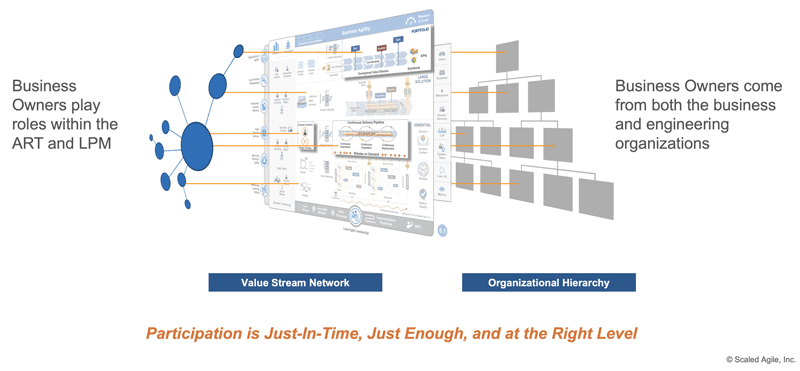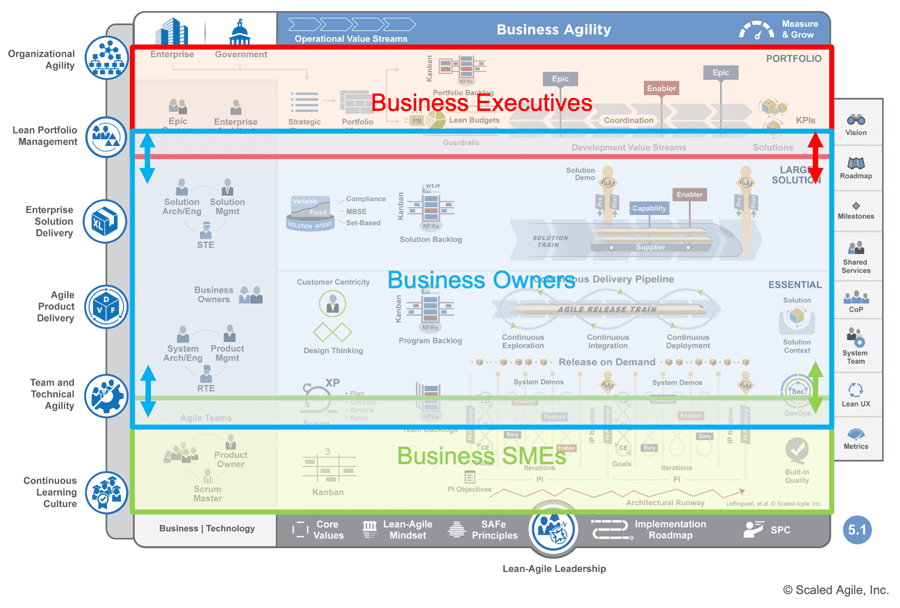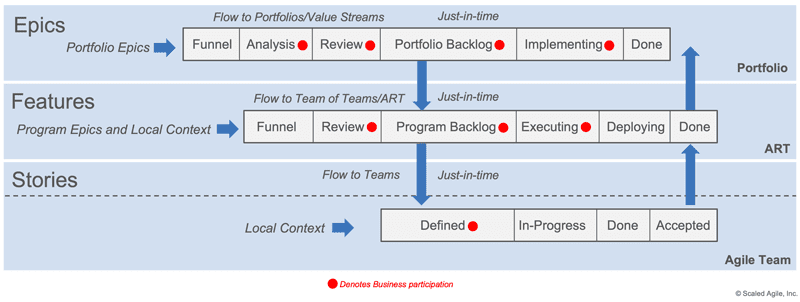Coming together is a beginning. Keeping together is progress. Working together is success.
— Henry Ford
Achieving Business Agility with Business Engagement
By Charlene M. Cuenca, SAFe Fellow
Note: This article is part of the Community Contributions series, which provides additional points of view and guidance based on the experiences and opinions of the extended SAFe community of experts.
Introduction
Alignment and Transparency are two core values in the framework. For true alignment, we need balanced participation from key functions in the organization. While we generally have heavy engagement from product, engineering, architecture, and delivery, in order to foster true Business Agility, we need help from those who are responsible for business operations as well.
This article provides additional guidance around the role of the Business Owner and focuses on how to foster and support engagement from our commercial team members who are responsible for the ‘business of the business’.
Business Owners in SAFe
SAFe describes business owners as follows:
“Business Owners are a small group of stakeholders who have the primary business and technical responsibility for governance, compliance, and return on investment (ROI) for a Solution developed by an Agile Release Train (ART). They are key stakeholders on the ART who must evaluate fitness for use and actively participate in certain ART events. Business Owners can be identified by asking the following questions:
- Who is ultimately responsible for business outcomes?
- Who can steer this ART to develop the right Solution?
- Who can speak to the technical competence of the solution now and into the near future?
- Who should participate in planning, help eliminate impediments, and speak on behalf of development, the business, and the customer?
- Who can approve and defend a set of PI plans, knowing full well that they will never satisfy everyone?
- Who can help coordinate the efforts with other departments and organizations within the Enterprise?
The answers to these questions will identify the Business Owners, who will play a key role in helping the ART deliver value.”
These are the key stakeholders on the ART, those who must evaluate fitness for use and actively participate in certain ART events; and those who are accountable for results, both business and technology.
Business Owners in the Dual Operating System
SAFe emphasizes a dual operating system. Each side is represented by Business Owners (Figure 1).
In the value stream network, representatives often include Product Managers, development managers, architects, and others who are directly involved in solution development. Generally, it’s relatively easier to identify them and keep them engaged.

But on the Organizational Hierarchy side of the dual operating system, things are not so straight forward. Here it isn’t so obvious who they are or how to get them engaged. This is discussed further in the following sections.
Business Responsibilities
One of the reasons it is not so obvious is that the operational value streams that are responsible for delivering products to the end users are often deep and complex. Multiple departments including operations, legal, finance, sales etc., are involved and there are many stakeholders. The need is to identify just a few of the right people that can represent the commercial and operational concerns. In our experience, there is no one person who can do this alone; a small team is necessary. We’ve typically found that there is a natural separation that helps map these roles in accordance with the differing planning horizons and responsibilities (Table 1).
- The business executive is the executive sponsor for the work and sets the vision and context during PI Planning. They may serve as a Business Owner for one or more ARTs.
- Business Owners include business leaders with production, operations, and/or solution delivery responsibilities. They know what the specific business needs are and often have fairly direct responsibility for outcomes.
- Business SMEs (often business analysts) and others from the Operational Value Stream understand in detail how the business operates and what functionality and acceptance criteria are needed. Many will serve in specific team and ART roles including product ownership, product owner, and product management and development team member.
Each may come from a different part of the organizational hierarchy but must work together to keep the strategic intent at the forefront. The goal is to ensure that these roles work together vertically (within the organizational hierarchy) and horizontally (with the other functional areas) to ensure engagement with the ART keeps the connection between strategy and execution alive for the ART.

Differing planning horizon responsibilities
In the enterprise, planning occurs across multiple horizons:
- The enterprise planning horizon is concerned with long-term, multi-year strategy that may span multiple portfolios. This typically requires enterprise executives and executives from multiple lines of business.
- The Portfolio planning horizon is concerned with single and/or multi-year strategy that spans multiple PIs and involves business executives
- The ART planning horizon is based on PIs and involves Business Owners who act as business managers.
- The team planning horizon is based on iterations and involves business SMEs.
The key to understanding the connection is to have different levels of the business participating just enough, just-in-time and at the right level, as summarized in Figure 2.

- Business executives take part in the portfolio planning horizon via the Portfolio Kanban, helping to define and validate the strategy in Portfolio Epics but may also influence the ART planning horizon and prioritization.
- The Business Owners take part in key PI events and planning and prioritization via the ART Kanban, but may also take part in Portfolio discussions, as well as help clarify strategic intent to the ART.
- Business SMEs participate in helping ART understand the business domains within the team planning horizon, but also take part in the overall ART planning horizon.
Business participation in Framework flow
Looked at from another perspective, these business roles participate in different Framework activities as described in Figure 3.

In addition, the business participates in defining and prioritizing the flow of work (Figure 4).

Business participation before, after, during the PI events
Of course, these activities take time, and it’s perhaps helpful to manage expectations. Figure 5 is an example of the various events where business may participate, including approximate durations, likely participants, and expected frequency. Keep in mind these are just suggested times and need to be applied within a specific ART or value stream context.

Summary
True Business Agility cannot be realized without direct involvement from those who are responsible for the ‘business of the business’. Ensuring the right level of business engagement, and representation from a broad set of business stakeholders, throughout the Framework has proven to deliver better business outcomes.